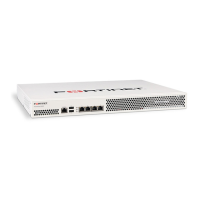Fortinet Technologies Inc. Page 42 FortiVoice 200D/200D-T v2.0 MR1 CLI Reference
extension ring-group
Use this sub-command to configure extension ring groups.
A ring group is a group of local extensions and external numbers that can be called using one
number. Local extensions and auto attendants can dial a ring group.
A ring group can reach a group of extensions. For example, ring group 301 can ring the sales
group at extensions 111, 112, 113, and 114. When a customer calls the sales group, the first
available salesperson answers for the group.
Syntax
config extension ring-group
edit <name>
set external-numbers <string>
set members <extension_number>
set mode {ring-all | ring-sequential}
set number <string>
set status {enable | disable}
set timeout <integer>
end
Variable Description Default
<name> Enter the ring group name.
external-numbers
<string>
Enter an external phone number to the ring group. For
example, you can add the number of a remote employee
to a ring group.
members
<extension_number>
Enter the available extensions or extension groups that
you want to include in the ring group.
20
mode {ring-all | ring-
sequential}
Select how you want the ring group to be called.
• ring-all: All extensions in the group will ring when
the ring group number is dialed.
• ring-sequential: Each extension in the group is
called one at a time in the order in which they have
been added to the group. You can set a timeout
period for each ring.
ring-
sequential
number <string> Enter the ring group number following the extension
number pattern. See the pattern-matching syntax and
pattern-matching examples in “pbx number-
management” on page 57.
The ring group number, once dialed, will ring all the
extensions in the group.
status {enable | disable} Enable or disable this ring group. enable
timeout <integer> Enter the amount of time in seconds allowing all
extensions or each one to ring before going to voicemail.
20

